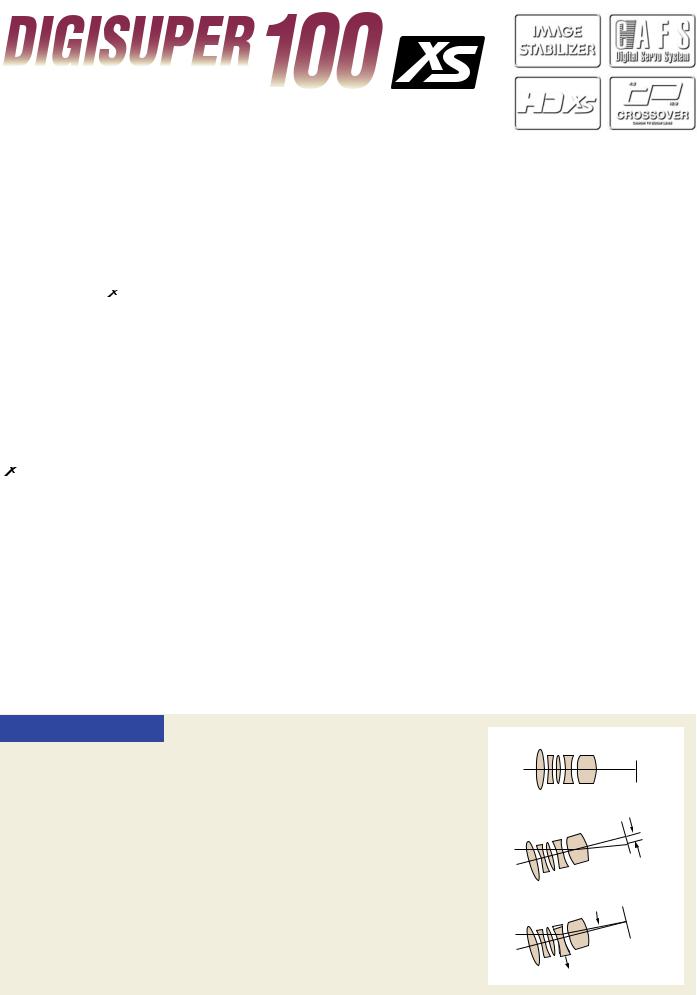Canon DIGISUPER 100 XS BROCHURE

XJ100x9.3B IE-D 9.3-930mm1:1.7
The Most Spectacular Advancement
In Field Lens Technology-with
Incredible Zoom Ratio and Image
Stabilizer

XJ100x9.3B IE-D 9.3-930mm1:1.7
Canon has always been the pioneer in the history of broadcast lens design. And now, Canon launches the first broadcast 100x zoom lens, named the DIGISUPER 100xs, the world’s first triple digit zoom lens. Triple digit zoom lens performance was a barrier that was never expected to be broken, and it took Canon’s unique technology to make it happen.
The DIGISUPER 100xs is the highest quality DIGISUPER series lens produced to date. With the advancement of Digital terrestrial broadcasting and satellite broadcasting, the market is requiring a dramatic increase in sports and large event programming. In order to acquire the largest audiences possible in this diversifying industry, it will be necessary to create more realistic and powerful pictures and the DIGISUPER 100xs will surely meet all your demands.

 : The letters "
: The letters "  " come from the word "Excess", an indication that the new generation of
" come from the word "Excess", an indication that the new generation of 
 lenses exceeds all conventional lens specifications and concepts by using breakthrough technologies.
lenses exceeds all conventional lens specifications and concepts by using breakthrough technologies. 
 allows for higher specification lenses in smaller and lighter packages. Knowing the requirements for HDTV, Canon has developed the DIGISUPER 100xs to meet and exceed those demanding performance specifications. Further enhancing the DIGISUPER 100xs series is Canon’s latest built-in stabilization method, Shift-IS, a standard feature of both lenses.
allows for higher specification lenses in smaller and lighter packages. Knowing the requirements for HDTV, Canon has developed the DIGISUPER 100xs to meet and exceed those demanding performance specifications. Further enhancing the DIGISUPER 100xs series is Canon’s latest built-in stabilization method, Shift-IS, a standard feature of both lenses.
 Optical Performance with a 100x Zoom Ratio
Optical Performance with a 100x Zoom Ratio
The DIGISUPER 100xs is a powerful field lens that utilizes Canon’s unique optical design concept, the “Power Optical System” with
“ Element”. By adopting this concept and advanced technology, The DIGISUPER 100xs has improved the range of focal length from 9.3mm-930mm and also has succeeded in compensating the chromatic aberration to a very high accuracy.
The superior optical capacity also allows the lens to offer a maximum relative aperture of 1.7 and a minimum object distance of 3.0 meters. Moreover, the DIGISUPER100xs is almost
the same size and weight as the DIGISUPER 86xs. Canon considers that, no matter how prominent the specifications, if the lens is huge and massive, it is meaningless as a production tool.
 Element & POWER OPTICAL SYSTEM
Element & POWER OPTICAL SYSTEM
Canon has developed this breakthrough optical design concept using a newly developed optical element in the most effective way.
We have named the new design concept the "Power Optical System" which achieves higher specifications and quality using the new optical
 Element" which virtually eliminates aberrations.
Element" which virtually eliminates aberrations.
"CAFS" Constant Angle Focusing System
The zooming effect of focus is the phenomena where the picture size (angle of view) changes when focusing (breathing). However, a 32bit CPU calculates and controls the zoom when focusing in order to counteract these phenomena. Thus the DIGISUPER 100xs have ZERO zooming effect of focus throughout the whole zoom range.
CROSSOVER COMPATIBILITY
Available optionally is the dual aspect ratio switching system, "CROSSOVER", for switchable 16:9/4:3 cameras.
Superior Image Stabilizer
The history of field lenses is a history of zoom ratio/focal length extension. It came to a point where the industry thought it would be impossible to push the envelope any further. The telephoto focal lengths of the lens got so long that even the slightest amount of wind or operator movement would cause image shake and viewing the picture became intolerable, this was before Canon announced the incredible magnification DIGISUPER 86xs zoom lens in 2000. Canon, renowned for its optical image stabilization technologies, developed another new superior stabilization solution for the broadcast field lens, a built-in Optical Shift Image Stabilizer (Shift-IS) to overcome image
shaking at telephoto focal length. Now the ShiftIS is employed in the DIGISUPER 100xs.
Image Stabilizer
How the Optical Shift Image Stabilizer (Shift-IS) Works
When the lens moves, the light rays from the subject are bent relative to the optical axis, resulting in an unsteady image because the light rays are deflected. By shifting the IS lens group on a plane perpendicular to the optical axis to counter the degree of image shake, the light rays reaching the image plane can be steadied. Since image shake occurs in both horizontal and vertical directions, two shake-detecting sensors for yaw and pitch, detect the angle and speed of movement and send this information to a high-speed 32-bit microcomputer, which converts the information into drive signals for the IS lens group. Then the actuator moves the IS lens group horizontally and vertically thus counteracting the image shake and maintaining the stable picture. The Shift-IS component is located within the lens groups and is most effective for lower frequency movements caused by platform vibration or wind effect without increasing the overall size and weight of the master lens.
1.Lens when still.
Image plane
To Subject
2.Lens when jerked downward.
Camera shake
3.Counteraction by IS lens group.
Corrected light rays
Position of IS lens group after shifting
